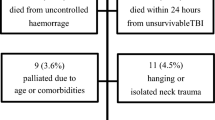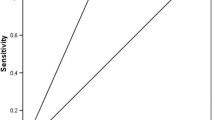Abstract
Purpose
This study aims to assess outcomes of pediatric patients with blunt traumatic brain injury (TBI) with a presenting Glasgow Coma Score (GCS) of 3.
Methods
After local institutional review board approval, we identified patients ages 0 to15 years with blunt TBI and a reported GCS of 3 between 2007 and 2017 from a pediatric level 1 trauma center prospective registry. Exclusion criteria were cardiac death on arrival and penetrating injury. We recorded clinical variables from patients with a non-pharmacologic GCS of 3 and pupillary exam documented by a neurosurgical attending or resident. The original Glasgow Outcome Scale (GOS) was used to compare with other studies. Importance of variables to survival was calculated.
Results
A total of 88 patients (mean age 6.9 years) were included with a mortality rate of 68%. Twelve percent had a poor long-term outcome (GOS 2 or 3) while 20% had a good long-term outcome (GOS 4 or 5). Median follow-up was 1.8 years. Initial group comparison revealed patients in group 1 (survivors) had less hypotension on arrival (14% SBP < 90 mmHg vs. 66%, p < 0.0001), higher temperatures on arrival (36.3 °C vs 34.9 °C, p = 0.0002), lower ISS (29.7 vs 39.5, p = 0.003), less serious injury to other major organs (34% vs 61%, p = 0.02), more epidural hematomas (24% vs 7%, p = 0.04), and less evidence of brain ischemia on CT (7% vs 39%, p = 0.002) or brainstem infarct, hemorrhage, or herniation (0% vs 27%, p = 0.002). Differences between the 2 groups in age, sex, race, MOI, AIS score, presence of midline shift > 5 mm, or time from injury to hospital arrival or time to surgery were not statistically significant. Classification tree analysis showed that the most important variable for survival was pupillary exam; mortality was 92% in presence of bilateral, fixed dilated pupils. The relative importance of initial temperature, MOI, and hypotension to survivability was 0.79, 0.75, and 0.47, respectively.
Conclusion
Twenty percent of our pediatric non-pharmacologic GCS 3 cohort had a good functional outcome. Lack of bilaterally fixed and dilated pupils was the most important factor for survival. Temperature, MOI, and hypotension also correlated with survival. The data support selective aggressive management for these patients.

Similar content being viewed by others
References
Taylor CA, Bell JM, Breiding MJ, Xu L (2017) Traumatic brain injury-related emergency department visits, hospitalizations, and deaths—United States, 2007 and 2013. MMWR Surveill Summ 66:1–16
Faul M, Coronado V (2015) Epidemiology of traumatic brain injury. Handb Clin Neurol 127:3–13
Rosario BL, Horvat CM, Wisniewski SR, Bell MJ, Panigrahy A, Zuccoli G, Narayanan S, Balasubramani GK, Beers SR, Adelson PD, Investigators of the Cool Kids T (2018) Presenting characteristics associated with outcome in children with severe traumatic brain injury: a secondary analysis from a randomized, controlled trial of therapeutic hypothermia. Pediatr Crit Care Med 19:957–964
Collaborators MCT, Perel P, Arango M, Clayton T, Edwards P, Komolafe E, Poccock S, Roberts I, Shakur H, Steyerberg E, Yutthakasemsunt S (2008) Predicting outcome after traumatic brain injury: practical prognostic models based on large cohort of international patients. BMJ 336:425–429
Steyerberg EW, Mushkudiani N, Perel P, Butcher I, Lu J, McHugh GS, Murray GD, Marmarou A, Roberts I, Habbema JD, Maas AI (2008) Predicting outcome after traumatic brain injury: development and international validation of prognostic scores based on admission characteristics. PLoS Med 5:e165 discussion e165
Young AM, Guilfoyle MR, Fernandes H, Garnett MR, Agrawal S, Hutchinson PJ (2016) The application of adult traumatic brain injury models in a pediatric cohort. J Neurosurg Pediatr 18:558–564
Chamoun RB, Robertson CS, Gopinath SP (2009) Outcome in patients with blunt head trauma and a Glasgow Coma Scale score of 3 at presentation. J Neurosurg 111:683–687
Demetriades D, Kuncir E, Velmahos GC, Rhee P, Alo K, Chan LS (2004) Outcome and prognostic factors in head injuries with an admission Glasgow Coma Scale score of 3. Arch Surg 139:1066–1068
Fulkerson DH, White IK, Rees JM, Baumanis MM, Smith JL, Ackerman LL, Boaz JC, Luerssen TG (2015) Analysis of long-term (median 10.5 years) outcomes in children presenting with traumatic brain injury and an initial Glasgow Coma Scale score of 3 or 4. J Neurosurg Pediatr 16:410–419
Kotwica Z, Jakubowski JK (1995) Head-injured adult patients with GCS of 3 on admission—who have a chance to survive? Acta Neurochir 133:56–59
Tien HC, Cunha JR, Wu SN, Chughtai T, Tremblay LN, Brenneman FD, Rizoli SB (2006) Do trauma patients with a Glasgow Coma Scale score of 3 and bilateral fixed and dilated pupils have any chance of survival? J Trauma 60:274–278
Emami P, Czorlich P, Fritzsche FS, Westphal M, Rueger JM, Lefering R, Hoffmann M (2017) Impact of Glasgow Coma Scale score and pupil parameters on mortality rate and outcome in pediatric and adult severe traumatic brain injury: a retrospective, multicenter cohort study. J Neurosurg 126:760–767
Jennett B, Bond M (1975) Assessment of outcome after severe brain damage. Lancet 1:480–484
Hastie T, Tibshirani R, Friedman JH (2009) The elements of statistical learning: data mining, inference, and prediction. Springer, New York
James G, Witten D, Hastie T, Tibshirani R (2013) An introduction to statistical learning: with applications in R. Springer, New York
Cicero MX, Cross KP (2013) Predictive value of initial Glasgow Coma Scale score in pediatric trauma patients. Pediatr Emerg Care 29:43–48
Hutchison JS, Guerguerian AM (2013) Cooling of children with severe traumatic brain injury. Lancet Neurol 12:527–529
Hutchison JS, Ward RE, Lacroix J, Hebert PC, Barnes MA, Bohn DJ, Dirks PB, Doucette S, Fergusson D, Gottesman R, Joffe AR, Kirpalani HM, Meyer PG, Morris KP, Moher D, Singh RN, Skippen PW, Hypothermia Pediatric Head Injury Trial I, the Canadian Critical Care Trials G (2008) Hypothermia therapy after traumatic brain injury in children. N Engl J Med 358:2447–2456
Adelson PD, Wisniewski SR, Beca J, Brown SD, Bell M, Muizelaar JP, Okada P, Beers SR, Balasubramani GK, Hirtz D, Paediatric Traumatic Brain Injury C (2013) Comparison of hypothermia and normothermia after severe traumatic brain injury in children (cool kids): a phase 3, randomised controlled trial. Lancet Neurol 12:546–553
Tasker RC, Akhondi-Asl A (2017) Updating evidence for using therapeutic hypothermia in pediatric severe traumatic brain injury. Crit Care Med 45:e1091
Acknowledgments
This study was supported by the Department of Neurosurgery at UTHealth.
Author information
Authors and Affiliations
Corresponding author
Ethics declarations
Conflict of interest
On behalf of all authors, the corresponding author states that there is no conflict of interest.
Additional information
Publisher’s note
Springer Nature remains neutral with regard to jurisdictional claims in published maps and institutional affiliations.
The abstract has been accepted for presentation at the American Association of Neurological Surgeons/Congress of Neurological Surgeons Section Meeting on Pediatric Neurosurgery in Nashville, TN on December 7, 2018.
Rights and permissions
About this article
Cite this article
Trimble, D.J., Parker, S.L., Zhu, L. et al. Outcomes and prognostic factors of pediatric patients with a Glasgow Coma Score of 3 after blunt head trauma. Childs Nerv Syst 36, 2657–2665 (2020). https://doi.org/10.1007/s00381-020-04637-z
Received:
Accepted:
Published:
Issue Date:
DOI: https://doi.org/10.1007/s00381-020-04637-z




